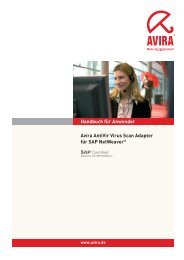Avira Managed Email Security (AMES)
Avira Managed Email Security (AMES)
Avira Managed Email Security (AMES)
Create successful ePaper yourself
Turn your PDF publications into a flip-book with our unique Google optimized e-Paper software.
<strong>Avira</strong> <strong>Managed</strong> <strong>Email</strong> <strong>Security</strong> (<strong>AMES</strong>)<br />
User Guide
Table of Contents<br />
Table of Contents<br />
1. Product information ................................................................. 4<br />
1.1 Functionality . . . . . . . . . . . . . . . . . . . . . . . . . . . . . . . . . . . . . . . . . . . . . . . . . . . . . . . . . . . . . . . .4<br />
1.2 Licensing <strong>AMES</strong> . . . . . . . . . . . . . . . . . . . . . . . . . . . . . . . . . . . . . . . . . . . . . . . . . . . . . . . . . . . . .5<br />
2. Getting started with <strong>AMES</strong> ........................................................ 6<br />
2.1 Adding a new domain to <strong>AMES</strong> . . . . . . . . . . . . . . . . . . . . . . . . . . . . . . . . . . . . . . . . . . . . . . . .6<br />
2.2 Logging in to <strong>AMES</strong> . . . . . . . . . . . . . . . . . . . . . . . . . . . . . . . . . . . . . . . . . . . . . . . . . . . . . . . . . .6<br />
2.3 Configuring the <strong>AMES</strong> domain . . . . . . . . . . . . . . . . . . . . . . . . . . . . . . . . . . . . . . . . . . . . . . . .7<br />
2.4 Scanning outgoing emails . . . . . . . . . . . . . . . . . . . . . . . . . . . . . . . . . . . . . . . . . . . . . . . . . . . .9<br />
3. Setting your <strong>AMES</strong> domains and users ........................................ 10<br />
3.1 Making general domain settings . . . . . . . . . . . . . . . . . . . . . . . . . . . . . . . . . . . . . . . . . . . . . 10<br />
3.2 Setting the services available to end-users . . . . . . . . . . . . . . . . . . . . . . . . . . . . . . . . . . . 11<br />
3.3 Adding new users to a domain . . . . . . . . . . . . . . . . . . . . . . . . . . . . . . . . . . . . . . . . . . . . . . 12<br />
3.3.1 Adding a new user . . . . . . . . . . . . . . . . . . . . . . . . . . . . . . . . . . . . . . . . . . . . . . . . . . . . . . . . 12<br />
3.3.2 Adding multiple users to a domain (Mass Add) . . . . . . . . . . . . . . . . . . . . . . . . . . . . . . . 14<br />
3.4 Import/ Export the list of domain users . . . . . . . . . . . . . . . . . . . . . . . . . . . . . . . . . . . . . . 15<br />
3.5 Adding a user alias . . . . . . . . . . . . . . . . . . . . . . . . . . . . . . . . . . . . . . . . . . . . . . . . . . . . . . . . . 16<br />
3.6 Resetting user passwords . . . . . . . . . . . . . . . . . . . . . . . . . . . . . . . . . . . . . . . . . . . . . . . . . . . 17<br />
3.7 Synchronization settings (LDAP/ CSV) . . . . . . . . . . . . . . . . . . . . . . . . . . . . . . . . . . . . . . . 18<br />
3.8 Domain queue information . . . . . . . . . . . . . . . . . . . . . . . . . . . . . . . . . . . . . . . . . . . . . . . . . 18<br />
3.9 Changing the email delivery options for a user . . . . . . . . . . . . . . . . . . . . . . . . . . . . . . . . 18<br />
3.10 Customizing email signatures . . . . . . . . . . . . . . . . . . . . . . . . . . . . . . . . . . . . . . . . . . . . . . 19<br />
3.11 Setting up an automatic reply . . . . . . . . . . . . . . . . . . . . . . . . . . . . . . . . . . . . . . . . . . . . . . 21<br />
4. Quarantine Management ........................................................ 22<br />
4.1 Configuring the email filters . . . . . . . . . . . . . . . . . . . . . . . . . . . . . . . . . . . . . . . . . . . . . . . . 22<br />
4.1.1 Handling intercepted spam or viruses . . . . . . . . . . . . . . . . . . . . . . . . . . . . . . . . . . . . . . . 22<br />
4.1.2 Adjusting the filter settings . . . . . . . . . . . . . . . . . . . . . . . . . . . . . . . . . . . . . . . . . . . . . . . . 24<br />
4.2 Setting up virus and spam notifications . . . . . . . . . . . . . . . . . . . . . . . . . . . . . . . . . . . . . . 27<br />
4.3 Managing the quarantines directly from your email account . . . . . . . . . . . . . . . . . . . 29<br />
4.4 Managing the quarantines from your <strong>AMES</strong> account . . . . . . . . . . . . . . . . . . . . . . . . . . . 31<br />
<strong>AMES</strong> User Guide (Status: 24 Jan 2012) 2
Table of Contents<br />
5. User management .................................................................. 34<br />
5.1 User management in advanced mode . . . . . . . . . . . . . . . . . . . . . . . . . . . . . . . . . . . . . . . . 35<br />
6. Statistics .............................................................................. 39<br />
7. Support ................................................................................ 42<br />
<strong>AMES</strong> User Guide (Status: 24 Jan 2012) 3
1. Product information<br />
Thank you for taking a look at the <strong>Avira</strong> <strong>Managed</strong> <strong>Email</strong> <strong>Security</strong> (<strong>AMES</strong>) manual.<br />
Product information<br />
This manual will help you get started with <strong>AMES</strong>, as well as customizing <strong>AMES</strong> to your<br />
specific needs. You will have peace in your inbox in no time.<br />
1.1 Functionality<br />
<strong>Avira</strong> <strong>Managed</strong> <strong>Email</strong> <strong>Security</strong> (<strong>AMES</strong>) is a service dedicated to stopping spam or viruses<br />
before they reach your company’s network. This is achieved by routing the emails to our<br />
<strong>AMES</strong> server cluster. <strong>AMES</strong> then scans and delivers the malware-free emails to your<br />
server.<br />
The most accurate spam scanning technology<br />
For intercepting spam, we use a combination of technologies proven to be extremely<br />
effective. Since spammers and virus makers become more skilled every day, we constantly<br />
test and implement new methods to keep our lead position in email scanning, and you<br />
enjoy the benefits of this without any extra effort.<br />
Configuring <strong>AMES</strong><br />
Because we stop spam and viruses "in the cloud", that is also the place where the<br />
configuration is done.<br />
You can log in to the <strong>AMES</strong> interface at https://ames.avira.com.<br />
Currently, the <strong>AMES</strong> interface is available in the following languages:<br />
• English<br />
• German<br />
• French<br />
• Spanish<br />
• Dutch<br />
<strong>AMES</strong> saves your language preference in a cookie or tries to match your browser’s<br />
language. In case of an unsupported language, the <strong>AMES</strong> interface opens in English.<br />
<strong>AMES</strong> User Guide (Status: 24 Jan 2012) 4
Release notes<br />
Product information<br />
To keep you up to date with the latest developments, we placed a link to the Release notes<br />
page (available at Partner and domain administrator levels only).<br />
1.2 Licensing <strong>AMES</strong><br />
When you let your <strong>Avira</strong> Partner purchase a license for <strong>AMES</strong>, you need to choose the<br />
number of users. These users correspond to the total number of people in your<br />
organization, that are going to use <strong>AMES</strong> to filter emails.<br />
<strong>AMES</strong> gives you total freedom to distribute these users across multiple domains, create<br />
aliases for them, set filtering rules, etc. but you should always keep your license up to date<br />
with the actual users. For more information, see the <strong>AMES</strong> terms and conditions on our<br />
website.<br />
<strong>AMES</strong> User Guide (Status: 24 Jan 2012) 5
2. Getting started with <strong>AMES</strong><br />
Getting started with <strong>AMES</strong><br />
You'll find that once your <strong>Avira</strong> Partner has set up a license for your domain, the rest of the<br />
configuration is surprisingly easy.<br />
If you don't have an <strong>Avira</strong> Partner yet, please take a look at the <strong>Avira</strong> Partner Locator on<br />
our website.<br />
2.1 Adding a new domain to <strong>AMES</strong><br />
To add a new domain to <strong>AMES</strong>, please call your <strong>Avira</strong> Partner. They will then register your<br />
details, request a license and add the domain to <strong>AMES</strong>.<br />
2.2 Logging in to <strong>AMES</strong><br />
The domain is created in <strong>AMES</strong> and you will receive an order confirmation email with the<br />
credentials for the <strong>AMES</strong> account and details such as DNS MX settings and Firewall<br />
settings.<br />
1. Open https://ames.avira.com in your browser, where you'll find the login screen:<br />
2. Fill in your Login name, the Domain you want to access, and your Password.<br />
These were written in the order confirmation your partner received.<br />
3. Click Login.<br />
You will see the <strong>AMES</strong> Service License Agreement (SLA), which you need to read and<br />
agree, to continue.<br />
<strong>AMES</strong> User Guide (Status: 24 Jan 2012) 6
2.3 Configuring the <strong>AMES</strong> domain<br />
Getting started with <strong>AMES</strong><br />
For each new domain, one generic user is created (see "The catch-all user" - page 12) and<br />
the mail delivery is set to the currently used mail server. This means, you can start using<br />
<strong>AMES</strong> without any further configuration and the email flow will not be interrupted.<br />
Normally, your partner carries out the domain configuration for you, but if for some reason<br />
you need to do this yourself, we'll guide you in the process.<br />
The Domain status assistant<br />
After logging in to <strong>AMES</strong>, click the Services tab in the Domain overview.<br />
The Domain status link opens the 5-step domain activation assistant, which shows the<br />
status of each step and eventually displays instructions to complete them:<br />
1. Domain validation<br />
2. Mail server delivery<br />
3. DNS settings<br />
<strong>AMES</strong> User Guide (Status: 24 Jan 2012) 7
4. Firewall settings<br />
5. User configuration<br />
Configuring the DNS server<br />
Getting started with <strong>AMES</strong><br />
To activate the scanning and filtering of incoming emails, you have to change the MXsettings<br />
in the DNS server for the domain. The correct records are in the order<br />
confirmation email.<br />
If correct, the MX records are displayed in green under Domain DNS information in the<br />
Services tab of the Domain overview.In case the MX records are not correctly set, a<br />
message in red is displayed. For example:<br />
Note<br />
Make sure there is no MX-record with a priority below 10; otherwise emails from<br />
your organization will not be scanned and filtered by <strong>AMES</strong>.<br />
Depending on the Time-To-Live (TTL) settings of your MX records, it might take<br />
up to 24 hours before DNS changes become active.<br />
<strong>AMES</strong> User Guide (Status: 24 Jan 2012) 8
Getting started with <strong>AMES</strong><br />
After directing the MX records to the <strong>Avira</strong> <strong>AMES</strong> cluster, the managed service is active<br />
and will scan and filter the incoming emails. The filtered and scanned emails will be<br />
delivered to the regular mailbox.<br />
Configuring security and firewall<br />
After DNS changes are complete and propagated correctly, make sure the receiving mail<br />
server accepts only emails coming from the <strong>AMES</strong> server cluster mentioned in the order<br />
confirmation email. This can be done through settings in the firewall or mail server itself.<br />
2.4 Scanning outgoing emails<br />
By default, <strong>AMES</strong> scans only the incoming emails. The relay service (scanning of outgoing<br />
emails) is initially deactivated.<br />
If you want <strong>AMES</strong> to scan your outgoing emails for viruses, please contact your <strong>Avira</strong><br />
partner, to activate the relay feature for your domain.<br />
With enabled relay service, the domain’s administrators will see the amount of filtered<br />
outgoing messages.<br />
A daily maximum amount of messages is set, depending on the number of users: the<br />
amount of users in the domain, multiplied by 50 (never less than 1000 messages). If this<br />
limit is reached, the administrators receive a bounce message.<br />
<strong>AMES</strong> User Guide (Status: 24 Jan 2012) 9
3. Setting your <strong>AMES</strong> domains and users<br />
3.1 Making general domain settings<br />
First, you should check the general settings of the new domain.<br />
1. In the Domain overview, click the Domain tab.<br />
Setting your <strong>AMES</strong> domains and users<br />
The Domain status link opens the 5-step domain activation assistant (see "The Domain<br />
status assistant" - page 7).<br />
2. Your partner can activate or deactivate your domain.<br />
The license type and the maximum number of users for the domain are displayed under<br />
Domain settings.<br />
3. In the <strong>Email</strong> domain administrator field, type the email address of the domain<br />
administrator.<br />
4. Insert the Default incoming SMTP server(s), which will apply to the new users you<br />
create.<br />
Add only one IP address or hostname on each line.<br />
If you want to assign these servers to all domain users, use the "Click here" link.<br />
5. In case you want to block the email accounts of certain users, but keep their<br />
quarantines for a while, add their email addresses in the Blocked recipients field.<br />
<strong>AMES</strong> User Guide (Status: 24 Jan 2012) 10
Setting your <strong>AMES</strong> domains and users<br />
When released from quarantine, blocked emails can be released as attachment or as the<br />
original message. To set this behavior for the entire domain, use the option Type of<br />
quarantine release:<br />
• Release as the original message - Send the original message to the users’ inboxes.<br />
• Release as an attachment - Send the blocked message as attachment to a warning<br />
email to the users’ inboxes.<br />
3.2 Setting the services available to end-users<br />
1. In the Domain overview, click the Services tab.<br />
2. Under Services available to users, you can enable or disable certain options for all the<br />
end-users of the selected domain.<br />
• Sender domain MUST exist - If the domain of the sender does not resolve, the message<br />
is considered spam.<br />
• SMTP Deliver - Messages are delivered to the SMTP mail server.<br />
• Mail forward - Messages are forwarded to another email address.<br />
• VirusScan - Messages are scanned for viruses.<br />
• SpamFilter - Messages are scanned for spam.<br />
• ContentFilter - Message components are scanned, according to the whitelist/ blacklist<br />
content rules.<br />
• Auto-reply - The users are allowed to activate the auto-reply service.<br />
• Users are allowed to change their own settings - The users can activate virus<br />
notifications and schedule quarantine reports.<br />
<strong>AMES</strong> User Guide (Status: 24 Jan 2012) 11
3.3 Adding new users to a domain<br />
Setting your <strong>AMES</strong> domains and users<br />
When <strong>AMES</strong> is configured for your domain, the users you provide have to operate properly.<br />
If an email is sent to the email address test@demo.domain, the user test has to exist, or<br />
the email will bounce back to the sender.<br />
The catch-all user<br />
By default, <strong>AMES</strong> has one catch-all user. A catch-all user is convenient because it<br />
receives emails for all users on your domain.<br />
Note<br />
<strong>Avira</strong> discourages the use of a "catch-all" setting. The best approach is to create<br />
a separate user account in <strong>AMES</strong> for every user you have. The LDAP feature<br />
can reduce the time spent on this task. Please contact your <strong>Avira</strong> partner for<br />
more information.<br />
3.3.1 Adding a new user<br />
1. To add a new user manually, go to the Domain overview and click the Users tab.<br />
2. Click Add user to open the Add user to domain dialog:<br />
Each User name is considered to be the primary email address of that user; any other<br />
email address of that specific user is considered an alias.<br />
<strong>AMES</strong> User Guide (Status: 24 Jan 2012) 12
Setting your <strong>AMES</strong> domains and users<br />
3. Type the User name and Password for your new user. The password has to be<br />
minimum 6 characters long. The password strength is shown as you type:<br />
4. If you'd like this user to be able to manage the domain’s settings on<br />
https://ames.avira.com, enable the Domain admin option.<br />
5. You can apply the settings from an existing user, by selecting it from the drop-down list<br />
Copy settings from.<br />
6. When finished, click Save.<br />
You will be warned that the user is disabled by default. This is done so you can review<br />
the settings before they take effect.<br />
7. To enable the user, click its name in the Users tab and activate the status option and the<br />
available services in the Services tab:<br />
• VirusScan - Messages are scanned for viruses.<br />
• SpamFilter - Messages are scanned for spam.<br />
<strong>AMES</strong> User Guide (Status: 24 Jan 2012) 13
Setting your <strong>AMES</strong> domains and users<br />
• ContentFilter - Message components are scanned, according to the whitelist/ blacklist<br />
content rules.<br />
• Auto-reply - The users are allowed to activate the auto-reply service.<br />
• SMTP Deliver - Messages are delivered to the SMTP mail server.<br />
• Mail forward - Messages are forwarded to another email address.<br />
3.3.2 Adding multiple users to a domain (Mass Add)<br />
1. To add multiple users at once, go to the Domain overview, click the Users tab and press<br />
Mass Add.<br />
2. Insert the names of the new users, one per line, in the User names area.<br />
3. You can apply the settings from an existing user, by selecting it from the drop-down list<br />
Copy settings from.<br />
4. The Mass Add feature generates random passwords and sends them by email to the<br />
users, if the option Send mail to users is set to yes.<br />
5. When finished, click Save.<br />
A message is displayed, with the list of users and passwords added to the domain.<br />
6. Send the new credentials to your new users, if the option Send mail to users was set to<br />
no.<br />
<strong>AMES</strong> User Guide (Status: 24 Jan 2012) 14
3.4 Import/ Export the list of domain users<br />
Setting your <strong>AMES</strong> domains and users<br />
<strong>Avira</strong>-Partners and <strong>AMES</strong> domain administrators can import/ export the list of the users of a<br />
domain in a csv-type file. The file is editable and contains the settings for each user. It can<br />
be used to easily add or modify the settings for a large number of users (mass updates).<br />
1. To carry out an import or export of the users’ list, go to the Domain overview, click the<br />
Domain tab and scroll down to the CSV Import/Export section.<br />
2. Click Export CSV and open the export file in an editor or save it on your system.<br />
You can make changes to the users’ settings in a spreadsheet, as needed.<br />
3. Then you can save the file as .txt and import it into the domain again, by clicking Import<br />
CSV on the Domain tab.<br />
4. In the Import File dialog, select the file from your system and click Upload.<br />
5. You can review the list of imported users and click sync, to finalize the import and<br />
generate new random passwords for all the users.<br />
Status symbols:<br />
- added user<br />
<strong>AMES</strong> User Guide (Status: 24 Jan 2012) 15
- modified user<br />
- deleted user<br />
3.5 Adding a user alias<br />
User aliases can be used to assign multiple email addresses to one user.<br />
1. If you'd like to create an alias, select the user from the Users tab.<br />
The Services tab for the selected user opens:<br />
Setting your <strong>AMES</strong> domains and users<br />
2. Add one or more email addresses in the <strong>Email</strong> aliases field<br />
(e.g. tester.one@domain.demo). Insert each of them on a new line, not separated<br />
by other characters.<br />
3. Click Save on the bottom of the page when done.<br />
<strong>AMES</strong> User Guide (Status: 24 Jan 2012) 16
Greylisting<br />
Setting your <strong>AMES</strong> domains and users<br />
Warning<br />
If you'd like to use a catch-all address, use the * placeholder<br />
(*@domain.demo), but please note:<br />
The use of a so-called catch-all setting, where every combination of characters<br />
in front of the domain name is accepted as an email address (*@example.com),<br />
makes your domain extra vulnerable to spam and viruses. This is why <strong>AMES</strong><br />
enables advanced greylisting for all catch-all users. This technique bounces<br />
emails from unknown senders the first time, and will accept only the second or<br />
later attempt. Because a lot of spam servers will not try to resend emails,<br />
greylisting significantly reduces the amount of emails that must be filtered and<br />
scanned.<br />
Note<br />
Since the time it takes for the emails to be re-delivered depends on the sender's<br />
mail server, thus delaying the email delivery, <strong>Avira</strong> discourages the use of a<br />
"catch-all" setting. The best approach is to create a separate user account in<br />
<strong>AMES</strong> for every user you have. The Domain synchronization feature can really<br />
cut the time spent on this task.<br />
3.6 Resetting user passwords<br />
Domain administrators and <strong>Avira</strong> partners can reset the passwords of all users of a domain,<br />
by generating random passwords.<br />
1. To reset all user passwords within a domain, go to the Domain overview, click the<br />
Services tab and scroll down to the Password reset section.<br />
2. Leave the option Send mail to users enabled (yes, default setting), if you want to send<br />
the new credentials to the users by email.<br />
3. Click Reset passwords, to generate the new credentials.<br />
A list of the generated data is displayed.<br />
<strong>AMES</strong> User Guide (Status: 24 Jan 2012) 17
Setting your <strong>AMES</strong> domains and users<br />
4. If you did not enable the option Send mail to users, make sure you save this list and<br />
send the credentials to each of the users.<br />
3.7 Synchronization settings (LDAP/ CSV)<br />
These settings are only available to <strong>Avira</strong> Partners, because of the possible consequences<br />
of misconfiguration. Please contact your <strong>Avira</strong> partner for more information.<br />
3.8 Domain queue information<br />
As <strong>Avira</strong>-Partner or domain administrator, you can view the statistics of Incoming,<br />
Outgoing and Retry queues per domain.<br />
1. Select a domain and click the Domain tab. Scroll down to the Domain Queue section:<br />
2. You can use the Reset Queue button, to empty the email queue.<br />
3.9 Changing the email delivery options for a user<br />
You can choose between delivery to your SMTP server (default setting) or forwarding the<br />
emails to another address (in case you temporary need this service).<br />
<strong>AMES</strong> User Guide (Status: 24 Jan 2012) 18
1. To change mail delivery settings, select a User and go to the Services tab.<br />
2. Under Mail deliver options, you can choose between two methods:<br />
Setting your <strong>AMES</strong> domains and users<br />
- Activate SMTP Deliver.<br />
Under SMTP Deliver server(s), you can add one or more hosts or IP addresses, to<br />
which <strong>AMES</strong> will deliver the emails.<br />
- Activate Mail forward.<br />
Under Forward your email to this address, you can type one or more email<br />
addresses to which <strong>AMES</strong> will deliver your emails.<br />
3. Click Save when done.<br />
3.10 Customizing email signatures<br />
<strong>AMES</strong> allows you to append a custom message (signature) to the bottom of an outgoing or<br />
incoming email.<br />
Note<br />
Please use only standard Western Latin/ Unicode characters in the signature<br />
text.<br />
Adding a signature to incoming emails<br />
You can add a user-specific signature to incoming emails.<br />
<strong>AMES</strong> User Guide (Status: 24 Jan 2012) 19
Setting your <strong>AMES</strong> domains and users<br />
1. Select the User you'd like to add a signature for and go to the Signature tab.<br />
2. Activate the option Signature for incoming email and write the text in the text area.<br />
-OR-<br />
Click the Reset to default link, to use a standard signature.<br />
3. Click Save.<br />
Adding a signature to outgoing emails<br />
You can add a domain-specific signature to outgoing emails, in case you use the Relay<br />
service (see 2.4 Scanning outgoing emails - page 9).<br />
1. Select the Domain you'd like to add a signature for and go to the Signature tab.<br />
<strong>AMES</strong> User Guide (Status: 24 Jan 2012) 20
Setting your <strong>AMES</strong> domains and users<br />
2. Activate the option Signature for outgoing email and write the text in the text area.<br />
-OR-<br />
Click the Reset to default link, to use a standard signature.<br />
3. Click Save.<br />
3.11 Setting up an automatic reply<br />
1. To set an auto-reply message to the emails received by a user (for example, an "out of<br />
office" reply), select the User, go to Services and activate the Auto-reply service:<br />
Note<br />
If the Auto-reply service is not listed for the selected user, the service has to be<br />
enabled by a domain administrator or <strong>Avira</strong> partner (see 3.2 Setting the services<br />
available to end-users - page 11).<br />
2. Type the reply message (using standard Western Latin/ Unicode characters) in the<br />
Auto-reply message text area:<br />
3. Click Save to apply the change.<br />
<strong>AMES</strong> User Guide (Status: 24 Jan 2012) 21
4. Quarantine Management<br />
4.1 Configuring the email filters<br />
Quarantine Management<br />
<strong>AMES</strong> comprises a variety of email filtering and analysis tools. You can configure your<br />
<strong>AMES</strong> account to remove infected emails immediately, to send them to quarantine or just to<br />
place a tag in their subject. Furthermore, you can set the heuristic level of the spam control,<br />
define advanced spam rules and content filtering rules.<br />
Note<br />
According to their company’s security policy, the domain administrators can<br />
configure the filters, the quarantines and the reports, and disable these options<br />
for the end-users.<br />
4.1.1 Handling intercepted spam or viruses<br />
By default, <strong>AMES</strong> sends all spam and filtered emails to quarantine. You may also choose a<br />
different behavior, such as to tag the email and then deliver it to the inbox, or even to<br />
remove it immediately.<br />
1. Choose a User for which you'd like to configure the spam and virus handling and click<br />
the Quarantine tab.<br />
<strong>AMES</strong> User Guide (Status: 24 Jan 2012) 22
Quarantine Management<br />
2. Select the action you want to apply to infected emails, spam emails or filtered content:<br />
- Under handle viruses: select Quarantine, if infected emails should be quarantined for<br />
14 days, then deleted; or select Remove, if infected emails should be deleted<br />
immediately (default setting).<br />
- Under handle spam: select Quarantine, if spam emails should be quarantined for 30<br />
days, then deleted (default setting); select Tag subject, to mark the subject of spam<br />
emails with ******[SPAM]******* in your inbox; or select Remove, if spam emails<br />
should be deleted immediately.<br />
- Under content filter: select Quarantine, if filtered emails should be quarantined for 30<br />
days, then deleted (default setting); select Tag subject, to mark the subject of filtered<br />
emails with ******[CF]******* in your inbox; or select Remove, if filtered emails<br />
should be deleted immediately.<br />
3. When released from quarantine, blocked emails can be released as attachment or as<br />
the original message. To set this behavior per user, use the option Type of quarantine<br />
release:<br />
<strong>AMES</strong> User Guide (Status: 24 Jan 2012) 23
Quarantine Management<br />
- Domain - Keep the setting made by the domain administrator for the entire domain<br />
(see 3.1 Making general domain settings - page 10).<br />
- Original - Send the original message in the user’s inbox.<br />
- Attachment - Send the blocked message as attachment to a warning email to the<br />
user’s inbox.<br />
4. Click Save to save the settings.<br />
4.1.2 Adjusting the filter settings<br />
If you'd like to change the settings for the SpamFilter and/or the ContentFilter, select a<br />
User, go to the Services tab and click on Advanced settings for the filter you'd like to<br />
adjust.<br />
SpamFilter<br />
On the Advanced settings page, click ProTAG. Here you can set the blocking level for the<br />
heuristic spam control, which is applied to your incoming emails.<br />
There are five levels of severity for the spam control, based on the heuristic spam score:<br />
• Very relaxed - blocks only messages with a heuristic spam score of 100%.<br />
• Relaxed - blocks only messages with a heuristic spam score greater than 90%.<br />
• Normal - blocks only messages with a heuristic spam score greater than 80%.<br />
<strong>AMES</strong> User Guide (Status: 24 Jan 2012) 24
• Severe - blocks messages with a heuristic spam score greater than 65%.<br />
• Very severe - blocks messages with a heuristic spam score greater than 55%.<br />
The default setting is Normal.<br />
Note<br />
For organizations with a normal rate of spam we recommend the Normal level.<br />
As a result of setting the SpamFilter to Severe or Very severe, legitimate email<br />
with spam properties might be blocked. That is why we advise that you monitor<br />
your Spam quarantine on a regular basis, and schedule a daily spam report.<br />
Quarantine Management<br />
Using the SpamFilter settings, you can also block or allow certain email senders, domains<br />
or hosts.<br />
1. For example, to add rules for email senders, click the Senders tab.<br />
2. Insert the email address of the sender in the field under Add a rule<br />
(e.g. example.blocked@otherdomain.com).<br />
3. Select the rule type: block or allow.<br />
4. Click Save, to add the rule.<br />
The rules are listed under Allow/block mail senders, with type-symbols:<br />
block (blacklist) or<br />
allow (whitelist).<br />
To delete a rule, click the X mark in the options column and click OK in the pop-up window.<br />
Use the Domains and Hosts tabs to add rules for blocking or allowing certain domains and<br />
IP addresses. The procedure is similar to the one for Senders.<br />
<strong>AMES</strong> User Guide (Status: 24 Jan 2012) 25
Note<br />
SpamFilter rules are also added when you use the whitelist options Safe Sender<br />
or Safe Domain in the <strong>Email</strong> Quarantine Summary.<br />
See "Whitelist Options" - page 29.<br />
Content Filter<br />
In the ContentFilter settings, you can set attachment rules or custom rules:<br />
Quarantine Management<br />
• Attachments: Click the checkboxes in the first column of the extensions list, to block<br />
certain file types.<br />
The list contains the following recommendations:<br />
- block: you should block this type of attachment.<br />
- block if unsure: if you are not sure whether you want to allow this kind of attachment,<br />
we recommend that you block it.<br />
- do not block: attachments accepted by default; you can block them if you want.<br />
To make the selection easier, you can use the option Select all/ none: Use it to select/<br />
deselect all the extensions, and then click the ones you want to block/allow.<br />
• Custom: You can create your own rules to block or allow emails<br />
<strong>AMES</strong> User Guide (Status: 24 Jan 2012) 26
To add a custom rule:<br />
1. Select a filter criterion from the drop-down list:<br />
- subject contains: allows or blocks emails containing a certain subject.<br />
- message contains: allows or blocks emails containing a certain string.<br />
Quarantine Management<br />
- message size larger than: blocks emails exceeding a maximum message size in Kb.<br />
2. Type the text you want to filter for (e.g. <strong>Avira</strong> Newsletter) or the maximum message<br />
size (e.g. 5120).<br />
3. Select the rule type: block or allow.<br />
4. Click Save, to add the rule.<br />
The rules are listed under Custom rules, with type-symbols:<br />
block (blacklist) or<br />
allow (whitelist).<br />
To delete a rule, click the X mark in the Delete column and click OK in the pop-up window.<br />
4.2 Setting up virus and spam notifications<br />
1. To schedule a report, select a User then click the Report tab.<br />
<strong>AMES</strong> User Guide (Status: 24 Jan 2012) 27
2. Enable Virus notification, to receive a warning by email, whenever a virus is<br />
intercepted.<br />
Quarantine Management<br />
3. Enable Spam quarantine to receive a daily summary of intercepted spam, according to<br />
the settings you make under Reporting options:<br />
• Report language - currently you can choose between: English, German, Spanish,<br />
French and Dutch.<br />
• Report address - insert one email address, to which <strong>AMES</strong> will send virus notifications<br />
and spam summary.<br />
• Report Times - by default, <strong>AMES</strong> sends the spam summary twice a day (e.g. 08:00,<br />
16:00). You can select different times or disable one of them.<br />
Further options for the report times:<br />
- Last report 100 - list of 100 items since the last report.<br />
- Last report 500 - list of 500 items since the last report.<br />
- Last 100 items - list of the last 100 items.<br />
- Last 500 items - list of the last 500 items.<br />
• Blacklist - <strong>AMES</strong> does not display the blacklisted items in the summary, if you enable<br />
this option.<br />
• Obvious Spam - <strong>AMES</strong> does not display items with a high spam score in the summary,<br />
if you enable this option.<br />
• Sort by - select a criterion to sort the summary list: Time, Sender, Subject, Score,<br />
TLD (top level domain).<br />
• Charset block - <strong>AMES</strong> does not display Russian or Chinese charsets in the summary, if<br />
you enable these options.<br />
• Send empty - <strong>AMES</strong> sends a report, even if there is nothing to show.<br />
4. When done click Save.<br />
Warning<br />
We advise that you let <strong>AMES</strong> generate a report on a daily basis, especially when<br />
you have just started using <strong>AMES</strong> or if you use severe filtering settings for spam.<br />
5. Click Generate Now, if you want to receive the quarantine summary per email<br />
immediately. To view a report history of the last 14 days, click Show Report.<br />
<strong>AMES</strong> User Guide (Status: 24 Jan 2012) 28
Quarantine Management<br />
As <strong>Avira</strong>-Partner or <strong>AMES</strong> domain administrator, you can generate a quarantine report and<br />
send it to all users of a domain: Go to the Domain overview > Services, scroll down to the<br />
Quarantine report section and click Send.<br />
4.3 Managing the quarantines directly from your email account<br />
Once the daily summary report is activated, the user receives an email every day, as<br />
scheduled, with the list of eventual new spam messages.<br />
Whitelist Options<br />
You can manage your quarantine directly from your email client, by using the links in the<br />
Whitelist Options column of the Quarantine Summary:<br />
• Click Release Only, to deliver the quarantined email to your inbox.<br />
• Click Safe Sender, to deliver the quarantined email to your inbox and to add the sender<br />
to the whitelist of your <strong>AMES</strong> SpamFilter, so the sender will never be blocked again.<br />
• Click Safe Domain, to deliver the quarantined email to your inbox and to add the<br />
sender’s domain to the whitelist of your <strong>AMES</strong> SpamFilter, so the domain will never be<br />
blocked again.<br />
<strong>AMES</strong> User Guide (Status: 24 Jan 2012) 29
Warning<br />
It is not recommended to use the Safe Domain option for public domains, such<br />
as gmail.com, yahoo.com, hotmail.com, etc.<br />
Quarantine Management<br />
If you wish to view your entire quarantine or manage your preferences, you can click the<br />
link to the <strong>AMES</strong> web interface, which opens the login page to your <strong>AMES</strong> account.<br />
You can first check the details of the quarantined message, by clicking its subject (e.g.<br />
Part-Time Work) in the Subject column of the Quarantine Summary.<br />
After checking the message details, like Quarantine reason and Message headers, you can<br />
still decide to release the message from quarantine, by clicking Release this message.<br />
If the Virus notification feature is enabled, the user receives a warning by email, each time<br />
a virus is detected in an incoming message. The warning contains details about the<br />
infected message and a link to the malware description on the <strong>Avira</strong> website.<br />
The user can check the Virus quarantine in the <strong>AMES</strong> account, to delete or release the<br />
quarantined email within 14 days.<br />
<strong>AMES</strong> User Guide (Status: 24 Jan 2012) 30
4.4 Managing the quarantines from your <strong>AMES</strong> account<br />
To open the quarantine, select a User then go to the Quarantine tab.<br />
Quarantine Management<br />
<strong>AMES</strong> has three different quarantines, for different types of filtering. Click the name of each<br />
quarantine, to check its contents.<br />
Virus quarantine<br />
If your account is set to quarantine infected emails for 14 days, the Virus quarantine stores<br />
all emails with virus signatures.<br />
To delete specific emails, select the items in the list and click Delete. To delete all the<br />
messages in this quarantine, click Delete All. <strong>AMES</strong> will automatically delete infected<br />
emails older than 14 days.<br />
Warning<br />
If you doubt whether a specific email contains a virus, do not release it. The virus<br />
filtering in <strong>AMES</strong> is almost never wrong. In case you decide an email is not<br />
infected, select it and click Release to deliver it to your inbox.<br />
<strong>AMES</strong> User Guide (Status: 24 Jan 2012) 31
Spam quarantine<br />
Quarantine Management<br />
If your account is set to quarantine spam emails for 30 days, the Spam quarantine stores<br />
all intercepted spam emails.<br />
To delete specific emails, select the items in the list and click Delete. To delete all the<br />
messages in this quarantine, click Delete All. <strong>AMES</strong> will automatically delete spam emails<br />
after 30 days.<br />
You can also filter the list by ID, sender, recipient or subject, using the Search feature:<br />
Select the filter criterion in the drop-down list (QuarantineID, Sender, Recipient, Subject),<br />
insert the string you are searching for (e.g. viagra) and press Search. If you want to<br />
delete the filter string and return to the initial list, click Clear.<br />
To release selected emails from the quarantine:<br />
• Click Release, to deliver the selected email to your inbox.<br />
• Click Release and remember as Not Spam, to deliver the selected emails to your inbox<br />
and no longer recognize emails from these senders as spam. Note, that this action will<br />
reduce the effectiveness of the spam filtering.<br />
• Click Release to admin, to deliver the selected emails to your domain administrator,<br />
who can check them for you.<br />
<strong>AMES</strong> User Guide (Status: 24 Jan 2012) 32
Note<br />
You can completely rely on <strong>AMES</strong> default settings, but if needed, you can<br />
customize them. If you set the spam filter too high, your spam quarantine could<br />
also intercept ham. 'Ham' is email falsely identified as spam. If you get ham in<br />
your quarantine, or receive emails falsely tagged as spam in your email client,<br />
you might want to check the Advanced settings of the SpamFilter (see<br />
"SpamFilter" - page 24).<br />
Content Filter quarantine<br />
Quarantine Management<br />
In the ContentFilter quarantine you will find all blocked emails, based on size, attachment<br />
or your own customized rules.<br />
If you decide to deliver a selected email to your inbox, click Release.<br />
To delete specific emails, select the items in the list and click Delete. To delete all the<br />
messages in this quarantine, click Delete All. <strong>AMES</strong> will automatically delete contentblocked<br />
emails after 30 days.<br />
<strong>AMES</strong> User Guide (Status: 24 Jan 2012) 33
5. User management<br />
User management<br />
As <strong>Avira</strong> partner or <strong>AMES</strong> domain administrator, you can manage all the users of a domain<br />
in the Domain overview, on the Users tab.<br />
The default view displays a list of the users and the services status for each user:<br />
• active or inactive user ;<br />
• user’s name and aliases (clicking a user’s name, takes you to the user level of the<br />
<strong>AMES</strong> interface);<br />
• active services: VirusFilter (AV), SpamFilter (AS), ContentFilter (CF);<br />
• email delivery method (SMTP or Forward );<br />
• symbol for domain administrators .<br />
<strong>AMES</strong> User Guide (Status: 24 Jan 2012) 34
5.1 User management in advanced mode<br />
User management<br />
If you enable the Advanced mode option, you can easily configure the services for single or<br />
multiple users in just three steps.<br />
1. First, select the group of settings from the drop-down list above the table:<br />
- General<br />
- Services<br />
- Filter options<br />
- Blacklist<br />
- Whitelist<br />
- Report general<br />
- Report content<br />
2. Then, select the users you want to edit:<br />
Click the checkboxes in the first column, to select the users. You can use the checkbox<br />
in the table header, to select or deselect all users.<br />
To sort the users list by the contents of a column, click the column header once or twice:<br />
one of the two grey arrows in the header turns black , to indicate the ascending or<br />
descending sort order.<br />
<strong>AMES</strong> User Guide (Status: 24 Jan 2012) 35
User management<br />
To filter the list by certain criteria, use one or more fields below the column headers.<br />
To clear all the filters and display the entire users list again, click the Reset filters<br />
button.<br />
3. Finally, make the changes to the users’ settings:<br />
If you just want to delete the selected users, click Delete selected then press OK to confirm<br />
the action.<br />
Click the Edit selected button, to start editing the services for the selected users. You<br />
can directly click Edit all, if the changes should apply to all users in the list.<br />
4. Click the Edit icons in the first column of the settings sheet and select the option you<br />
want to activate for the selected users.<br />
<strong>AMES</strong> User Guide (Status: 24 Jan 2012) 36
5. Click Next to review the changes.<br />
6. You can click Show or Hide, to display or to hide the list of selected users in the<br />
overview window.<br />
7. Click Apply, then Close.<br />
The changes you made will be updated in the Users view.<br />
Overview of the settings available in Advanced mode<br />
Groups of settings Settings Options<br />
General (See 3.3 Adding new users to a domain - page 12)<br />
Active Yes / No<br />
Administrator Yes / No<br />
Delivery SMTP Deliver (+ hostname or IP)<br />
Mail forward (+ email address)<br />
Services (See 3.3 Adding new users to a domain - page 12)<br />
VirusScan Enabled / Disabled<br />
SpamFilter Enabled / Disabled<br />
ContentFilter Enabled / Disabled<br />
Filter options (See 4.1 Configuring the email filters - page 22)<br />
Viruses Quarantine / Remove<br />
Spam Quarantine<br />
Tag subject<br />
Remove<br />
Content filter Quarantine<br />
Tag subject<br />
Remove<br />
User management<br />
<strong>AMES</strong> User Guide (Status: 24 Jan 2012) 37
Groups of settings Settings Options<br />
Spam level Very relaxed<br />
Relaxed<br />
Normal<br />
Severe<br />
Very severe<br />
Release type Domain<br />
Original<br />
Attachment<br />
Blacklist / Whitelist (See 4.1.2 Adjusting the filter settings - page 24)<br />
Senders Add entries / Delete entries<br />
(+ sender addresses)<br />
Domains Add entries / Delete entries<br />
(+ sender domains)<br />
Hosts Add entries / Delete entries<br />
(+ hosts)<br />
Report general (See 4.2 Setting up virus and spam notifications - page 27)<br />
Virus notification Enabled / Disabled<br />
Quarantine report Enabled / Disabled<br />
Language English / German<br />
Recipient Use the box address of each user<br />
Use a general address for all users (+<br />
email address)<br />
Report Times Time of day<br />
Report content (See 4.2 Setting up virus and spam notifications - page 27)<br />
Report contents Last report 100<br />
Last report 500<br />
Last 100 items<br />
Last 500 items<br />
Blacklisted Show / Hide<br />
Obvious Spam Show / Hide<br />
Character-set None<br />
Russian<br />
Chinese<br />
Both<br />
Empty report Enabled / Disabled<br />
User management<br />
<strong>AMES</strong> User Guide (Status: 24 Jan 2012) 38
6. Statistics<br />
<strong>AMES</strong> creates statistics regarding the scanned emails, intercepted viruses, spam and<br />
filtered content, per domain and per user. Click the Statistics tab, to check them out.<br />
The information about the processed emails is divided into:<br />
Statistics<br />
• incoming (green) - the amount of incoming emails; the dark-green segment represents<br />
the incoming emails, for which greylisting was NOT applied. Greylisting is only applied<br />
to catch-all users. See "Greylisting" - page 17.<br />
• outgoing (blue) - the amount of outgoing emails, if the relay service is enabled.<br />
See 2.4 Scanning outgoing emails - page 9.<br />
• not scanned (brown) - the amount of not scanned emails, due to disabled filters.<br />
• Virus blocked (red) - the amount of emails intercepted by the Virus Filter.<br />
• Spam blocked (orange) - the amount of emails intercepted by the Spam Filter, including<br />
blacklisted items; the dark-orange segment represents the emails stored in the spam<br />
quarantine.<br />
• CF blocked (grey) - the amount of emails intercepted by the Content Filter.<br />
Note<br />
Statistics are generated daily at 1:00 AM (UTC).<br />
You can change the time range of the statistics, using the select period menu: yesterday,<br />
current month, last month, current year, or the previous year.<br />
<strong>AMES</strong> User Guide (Status: 24 Jan 2012) 39
Statistics<br />
If you select for example, the current month, day-by-day statistics are also available for the<br />
selected user or domain. Similarly, if you select a year, you can see month-by-month<br />
statistics, for a user or domain.<br />
You can also check the report on the Top 10 viruses that have been intercepted by <strong>AMES</strong><br />
in the selected period.<br />
<strong>AMES</strong> User Guide (Status: 24 Jan 2012) 40
Further statistics display the Top 25 senders and Top 25 recipients of emails during the<br />
selected period.<br />
Statistics<br />
<strong>AMES</strong> User Guide (Status: 24 Jan 2012) 41
7. Support<br />
Support service<br />
All necessary information on our comprehensive support service can be obtained from our<br />
website http://www.avira.com.<br />
FAQs<br />
Support<br />
Please also read the FAQ section on our website.<br />
Your questions may already have been asked and answered by other users in this section.<br />
Please contact your <strong>Avira</strong> Partner - they will be more than willing to help you with any<br />
further questions regarding <strong>Avira</strong> products.<br />
Contact<br />
Address<br />
<strong>Avira</strong> Operations GmbH & Co. KG<br />
Kaplaneiweg 1<br />
D-88069 Tettnang<br />
Germany<br />
Internet<br />
You can find further information about us and our products at the following address:<br />
http://www.avira.com<br />
<strong>AMES</strong> User Guide (Status: 24 Jan 2012) 42
This manual was created with great care. However, errors in design and contents<br />
cannot be excluded. The reproduction of this publication or parts thereof in any form<br />
is prohibited without previous written consent from <strong>Avira</strong> Operations GmbH & Co. KG.<br />
Issued Q1-2012<br />
Brand and product names are trademarks or registered trademarks of their<br />
respective owners. Protected trademarks are not marked as such in this manual.<br />
However, this does not mean that they may be used freely.<br />
© 2012 <strong>Avira</strong>. All rights reserved.<br />
E&OE.<br />
<strong>Avira</strong> Operations GmbH & Co. KG<br />
Kaplaneiweg 1 | 88069 Tettnang<br />
Germany<br />
Telephone: +49 7542-500 0<br />
Facsimile: +49 7542-500 3000<br />
www.avira.com

















